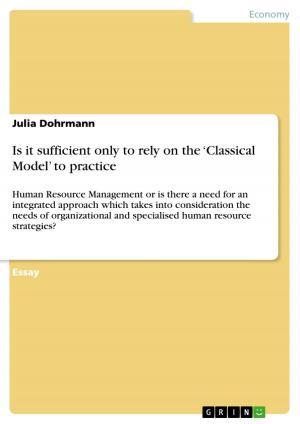From Science to the Economic System
Der Weg von der Wissenschaft in die Wirtschaft
Business & Finance, Entrepreneurship & Small Business, New Business Enterprises| Author: | Tobias Kleinmann | ISBN: | 9783640674909 |
| Publisher: | GRIN Publishing | Publication: | August 3, 2010 |
| Imprint: | GRIN Publishing | Language: | English |
| Author: | Tobias Kleinmann |
| ISBN: | 9783640674909 |
| Publisher: | GRIN Publishing |
| Publication: | August 3, 2010 |
| Imprint: | GRIN Publishing |
| Language: | English |
Seminar paper from the year 2010 in the subject Business economics - Company formation, Business Plans, grade: 1,0, University of Würzburg (Betriebswirtschaft), course: Academic Entrepreneurship, language: English, abstract: There has been a conspicuous increase in patenting and licensing, which is an indicator for an aggrandisement of academic entrepreneurship at American research universities since the 1970s. The number of patents which can be issued to universities and colleges increased by more than 100 percent between 1979 and 1984, as well as between 1984 and 1989. It almost doubled once more during the 1990s. In 1980 only about 20 research universities had technology licensing and transfer offices. 10 years later that number was 200, and in 2000 just about every major research university had founded its own (Colyvas et al., 2002, P. 1). University license revenues have increased from $220 million to $698 million from 1991 to 1997 (Association of University Technology Managers, 1998). Private sector activity is always associated with the risk of failure because of the responsibility which is connected with it. This leads us to the discussion why academics should escape from a 'safe world' of their publicly financed institution to either become entrepreneurs or to work in private companies. What are the major reasons for the risk of entrepreneurial and private sector activity? The following paper tries to find an answer on this question by blending theoretical backgrounds and empirical elements. The second chapter serves as an introduction to the subject where the issue of the paper is narrowed further down and the key questions of it are defined. The main characteristics and concepts will also be distinguished in the second chapter, as much as it will be presented which aspects are not discussed in the paper. The third chapter of this paper concentrates on how internal and external factors influence the decision of scientists to show entrepreneurial behaviour. There are different theories and surveys which try to find an answer to the question how important different elements are. The fourth chapter works out the details in differences of the factors leading either to academic spinoffs or private firm participations. The conclusion gives the final answer on how the theory and the empiricism correspond with each other and which reasons are responsible for academics to break out from the ivory tower of science.
Seminar paper from the year 2010 in the subject Business economics - Company formation, Business Plans, grade: 1,0, University of Würzburg (Betriebswirtschaft), course: Academic Entrepreneurship, language: English, abstract: There has been a conspicuous increase in patenting and licensing, which is an indicator for an aggrandisement of academic entrepreneurship at American research universities since the 1970s. The number of patents which can be issued to universities and colleges increased by more than 100 percent between 1979 and 1984, as well as between 1984 and 1989. It almost doubled once more during the 1990s. In 1980 only about 20 research universities had technology licensing and transfer offices. 10 years later that number was 200, and in 2000 just about every major research university had founded its own (Colyvas et al., 2002, P. 1). University license revenues have increased from $220 million to $698 million from 1991 to 1997 (Association of University Technology Managers, 1998). Private sector activity is always associated with the risk of failure because of the responsibility which is connected with it. This leads us to the discussion why academics should escape from a 'safe world' of their publicly financed institution to either become entrepreneurs or to work in private companies. What are the major reasons for the risk of entrepreneurial and private sector activity? The following paper tries to find an answer on this question by blending theoretical backgrounds and empirical elements. The second chapter serves as an introduction to the subject where the issue of the paper is narrowed further down and the key questions of it are defined. The main characteristics and concepts will also be distinguished in the second chapter, as much as it will be presented which aspects are not discussed in the paper. The third chapter of this paper concentrates on how internal and external factors influence the decision of scientists to show entrepreneurial behaviour. There are different theories and surveys which try to find an answer to the question how important different elements are. The fourth chapter works out the details in differences of the factors leading either to academic spinoffs or private firm participations. The conclusion gives the final answer on how the theory and the empiricism correspond with each other and which reasons are responsible for academics to break out from the ivory tower of science.















